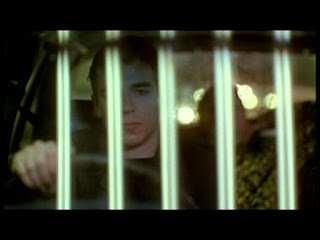 |
| Figure 1 |
The bars of light in figure 2 create a sense of claustrophobia and present that the character may feel trapped in the dreariness of his surroundings. They are also suggestive of prison bars, which could foreshadow his fate as he enters the world of crime. Additionally, the protagonist is in focus and the rule of thirds is used which positions us with the character.
The washed-out colour palette of the bleak setting in figure 3 connotes misery and hopelessness. The vanishing point of the path is off-center, which creates a sense of disorientation and suggests a lack of direction in the desperate lives of the characters. Figure 3 is an extreme long shot, which emphasises the barrenness of the expansive marsh and presents the unnamed character as small in comparison; this reinforces the character's powerless as he appears weak and insignificant, presenting themes of disillusionment and hopelessness.





